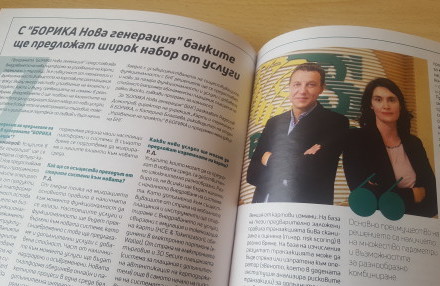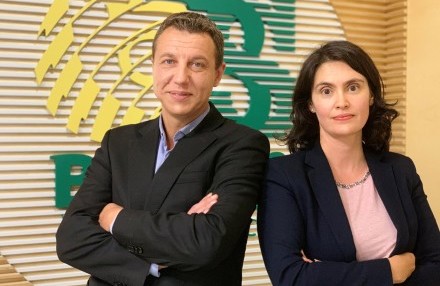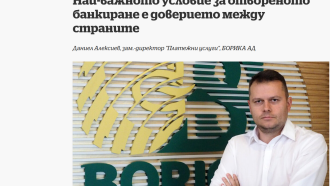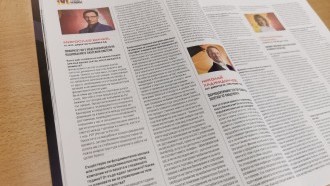CIO magazine: "BORICA New Generation" will allow banks to offer a wide range of new services
The BORICA New Generation program is related to the implementation of a new platform for cards, terminals and merchants management. In fact, it is a combination of technologies and functionalities in the field of card payments, with a great focus on multilayer customer and product management, as well as on real-time fraud prevention. Its implementation will allow the company's clients to offer a wide range of new services, including in the field of e-commerce, tokenization and digital portfolio in a flexible and fast way. The main goal of BORICA New Generation is to quickly and effectively impose the banks and payment institutions’ business requirements and to provide them with the new platform as a service.
Together with the upgrading of the existing functionalities, by the BNG implementation will be also provided new functionalities and value-added services on the market (e.g. recurring payments, equal instalment payments, flexible loyalty programs).
Radoslav Dimitrov, director of the Cards and Terminals Directorate at BORICA, and Katerina Blagoeva, Head of Project Management Department at BORICA and Program Manager of BNG will tell us more about BORICA New Generation (BNG).
- What is the model of offering the service in the BORICA New Generation Program?
Radoslav Dimitrov: The services in BORICA New Generation will be offered under the SaaS model. We provide the infrastructure and software, and banks or payment institutions operate their portfolio of products, clients and services of the platform. Their only responsibility is the management of business requirements and functionalities, without any commitment to maintain the infrastructure, to implement the requirements of local and international card schemes, as well as to comply with the regulations and requirements of international security standards such as PCIDSS (Payment Card Industry Data Security Standards). BORICA takes care of all this.
Katerina Blagoeva: The convenience for our clients (banks and payment institutions) is that the whole solution together with the required infrastructure is implemented in Borica and they use it as a service after paying a subscription fee. The new card platform provides a set of modern services in the card business for both the issuer and acquirer. With its help, our clients will be able to offer additional services such as installment payments, flexible loyalty programs, e-wallets and card products simulation (HCE - Host Card Emulation). The program is a process related to the design, development, testing, and implementation of the new card solution, in which we replace and update a number of our current platforms and systems. At the same time, we prepare to migrate our clients - Bulgarian banks and payment institutions, to the new environment.
- How will be carried out the transition from the old system to the new one?
R.D.: From point of view of the migration, the main rule is to keep the available functionality at the moment. The current services and functionalities will be transferred to the new system, and at the same time we will offer additional value-added services. Part of the currently available services will be updated and upgraded. The new platform unites online and package processes in an environment without additional integration, which will allow fast implementation of new products in it.
- How did you choose the WAY4 system?
К. B.: We researched all world-leading card systems. A major advantage of the solution we chose is the availability of multiple parameters and the possibility of their diverse combination when defining products and services. This, together with the integrated platform, ensures the rapid launch of services on the market. The bank or the payment institution can independently make changes to its products and personalize them in detail. Using the new platform as a service allows even our younger clients to take advantage of the benefits of a leading card system and offer more diverse and innovative card services.
- What new services can card issuers offer?
R. D.: The services that can be offered in the new environment are various. Of course, not all will be available with the initial implementation of the system. In addition to the existing services, as to the mobile payments and tools, we will start with the implementation of card emulation and tokenization services (HCE & Tokenization), united in e-Wallet. As to the e-commerce and 3D Secure payments (payment system with additional cardholder authentication), at the very start of the system launch will be added the possibility of risk-based authentication, strong client authentication or recurring payments management. In addition, the system enables real-time card fraud prevention.
- How will be improved the card fraud prevention?
К. B.: On the basis of pre-defined rules, the platform enables real-time prevention, i.e. a transaction can be canceled before it is made. These rules may be common to all or specific to each institution. Each institution will have its own share in the platform where its products and business requirements will be configured, including its rules for card fraud prevention. Based on these pre-set rules, the transaction is scanned and evaluated (the so called "risk scoring") in real time. According to the calculated result, the transaction may be canceled or sent to an operator (unit that analyzes the risky transactions in the institution) for further analysis. Depending on the rules and procedures of each institution, the operator may, for example, contact the cardholder in order to assess whether the suspicious transaction was fraudulent or not. The system also allows a subsequent analysis to be executed, showing whether the transactions, identified as a potential risk, were actually fraudulent.
R. D.: An example of card fraud prevention is the presence of a certain (higher than usual) number of transactions made by the cardholder for a definite period of time. For this purpose, the system stores the transactions made for each user and creates a profile. On its basis is made a behavioral analysis and in the presence of a great number of transactions for a short period of time, the system may prohibit the subsequent transactions for that cardholder beyond the model of their usual behavior. The execution of this type of analysis is determined on the basis of the pre-set rules by the institution issuing the payment card. The behavioral profile provides possibility for better definition of risk management rules for both the cardholder and the merchant. In addition to the behavioral analysis in the system, many different rules related to the restriction of suspicious traders can be defined. They can be both individual to each acquirer or general. On their basis, the system decides whether or not to cancel a transaction and whether it shall be marked as suspicious.
Rules may be defined in a different way - from merchant to cardholder, from value to number of transaction, geographic location, etc. where different sections between these parameters are possible, additionally related in time.
- At what stage is the implementation of the platform?
К. B.: The project consists of 12 stages. This year we started with the first one, which is quite complex, and we are at the level of functional and acceptance tests. The second phase is running parallel. Each phase begins with a detailed study and design of the solution for the specific functional area, followed by the configuration processes and, if necessary, additional programming, followed by delivery and testing in BORICA. After each phase there will be a controlled release in a real environment (pilot testing) and only after it has been carefully examined it goes into a real environment. Right now we are at the stage of completing the first phase tests and finalizing the detailed study of the second phase. The first phase is acceptance of transactions on ATMs, along with all their functionalities that need to be transferred from the existing into the new environment. Parallel to this, part of the first phase is the establishment of the so called National Switch. The second phase is the acceptance of POS terminals transactions.
- When banks will be able to take advantage of the BORICA New Generation Program?
К. B.: The full implementation in BORICA will take up to two and a half years. In parallel, we will migrate the current business of our clients in the new environment. Currently we prepare pilot deployments of a few ATMs of several banks. The goal is these devices to cover all available ATM devices and functionalities on the market. We expect within a few weeks to make sure that we have stable system behavior in a real environment, and then we can start with migrations. We expect the real ATMs transfer to the new environment to begin in January. Similar is the timetable for switching institutions with their own authorization centers to the newly established National Swtich. With the implementation and stabilization of the next 11 phases of the project, we will be ready to gradually adopt our clients' business entirely on the new platform. Migrations will be carried out in the form of parallel projects.
R. D.: Our expectations are to finish the project by the middle of 2020.
- What is the team involved in the project?
К. B.: It consists mainly of employees of BORICA and OpenWay - the system provider. Certain parts, if necessary, are assigned to subcontractors, e.g. upgrading our existing systems to integrate with the new platform. BORICA’s team has grown bigger after the launch of the BNG program. The company has created a core for management of BORICA New Generation with its own resource. We have a team of highly skilled and experienced colleagues, who have been working in banks and payment institutions, professional project managers, IT and other professionals with the necessary profile and experience.
Source: CIO magazine










